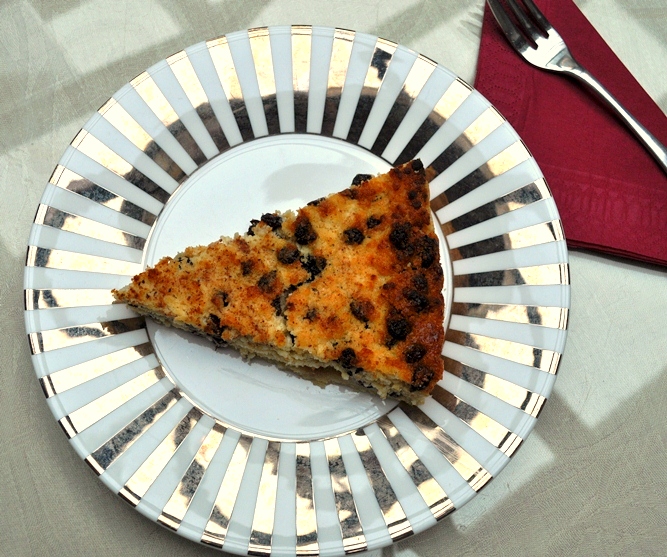Our first cake adventure a few weeks ago took me to Yorkshire. Stepping into one of the many, many tea rooms in York I was presented with a trolley of cakes. One of these was a giant Yorkshire curd tart. Now, I’ve been to Yorkshire many times, but I’d not yet sampled one of these, nor had I even seen enough of them to be able to identify it without help. Shame on me. Given I’d spent the morning eating cake, the predominance of eggs and slight cheesiness of this tart made it quite an obvious choice to sample. Not to mention my intention to sample local specialities as well.

There isn’t an especially elegant way to describe a Yorkshire curd tart that will make it sound appealing. It’s an open pie with a short crust and a slightly lumpy custard-like filling (this is the “curds”). Studded with currants and incorporating nutmeg and lemon, I can imagine this dessert wouldn’t be to everyone’s liking, but if you’ve grown up in England there is something comforting about the combination of a baked sweet egg mixture with currants and crisp pastry or bread crunch to balance the texture. I’m still a sucker for bread and butter pudding. I particularly liked that this tart wasn’t an overly sweet tart. Despite the similarities in ingredients, I shouldn’t really compare A Yorkshire curd tart to a bread and butter pudding. The nutmeg is much more predominant, it also includes lemon, and the curds are very unique in texture. Where a bread and butter pudding is mostly made up of the egg and milk soaked bread, the curd mixture is the star of this pudding.
What they do have in common is that they have both been part of English baking for a very long time and came about as a way to use up leftover ingredients to provide a sweet treat for the family.
What exactly are curds?
Do you remember the Little Miss Muffet poem? Sat on her tuffet, eating her curds and whey? Curds and whey are both part of the cheese making process. Before we started pasteurising and homogenising milk, left to sour in warm conditions it would separate into lumps of soft protein (the curds) and cloudy liquid that’s also full of protein (the whey). The curds would be pressed and aged (fermented) to become cheese. With pastuerised milk, or to hurry the process, if you add lemon juice or something similarly acidic to warmed milk, stir and then leave it, you will see the same separation. To make most cheese, rennet is commonly used.
The story goes that generally farmers would have more curds than they wanted to make cheese with, so they used these leftover curds to make into these lovely tarts.
So what exactly goes into a Yorkshire curd tart?
There are many recipes online, but essentially the ingredients are as below; mostly store cupboard ingredients. Check you have them and then have a hunt online for a recipe. Let us know what you find. When we’ve finished travelling the country tasting cake, we might get back in the kitchen to bake one. In the meantime I’ll leave it in your hands. If you find and would recommend a good recipe, please let us know in the comments below.
NOTE: Do make sure the ingredients include nutmeg. I saw at least one that doesn’t and it isn’t a proper curd tart without it. And also don’t even think about making it with cottage cheese!
Fine Shortcrust Pastry
Plain flour
Caster sugar
Butter
Water or milk
Egg yolks (optional)
For the filling
Full fat milk
Juice and zest of a lemon
Unsalted butter
Caster sugar
Nutmeg
Egg
Currants
Rosewater (optional)
Cinnamon (optional)